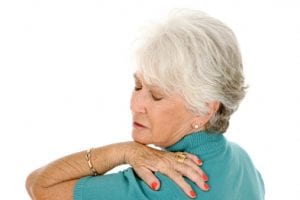Joint pain often occurs at the same time as menopause and it affects many women. While there is no clear reason for these achy and swollen joints, some doctors believe it may be due to falling estrogen levels. Estrogen is thought to protect joints and reduce inflammation, and when these levels drop during menopause, inflammation can increase or cause joint pain.
To learn what menopausal joint pain feels like, what the connection between menopause and joint pain is, and how to relieve menopausal joint pain, continue reading.
What does menopausal joint pain feel like
Menopausal joint pain is often at its worst in the morning when joints are stiff from disuse overnight. As the day progresses and movement increases, your pain may lessen because the joints are loosening up. Joints that are frequently affected during menopause are the neck, jaw, shoulders, and elbows, through the wrists and fingers may also experience some pain. The discomfort is characterized by stiffness, swelling, shooting pains, and even a burning sensation after working out.
Connection between menopause and joint pain
While joint pain is a common side effect of aging, is it also a symptom of menopause? Stiff joints that are swollen or even warm to the touch may be caused by changing hormone levels, though some medical professionals believe that this pain is not a direct result of menopause. Rather, the lower estrogen levels associated with menopause can increase the risk of osteoporosis and osteoarthritis in women over 50, resulting in the joint pain that is being attributed to menopause itself.
Osteoporosis is the thinning of the bones and can be accelerated by the lower levels of estrogen seen in menopause. Thin and brittle bones put women at risk for developing osteoarthritis, which is characterized by swollen and painful joints. While there may not be a physical link between menopause and joint pain, they often occur around the same time and symptoms of menopause may put women at risk for developing conditions that can cause joint pain.
Another factor of joint pain in menopause is dehydration. When the body is dehydrated then uric acid can accumulate, which triggers inflammation in the joints. Because estrogen is a key player in fluid regulation it also plays a role in your dehydration levels. You see, when estrogen levels drop, so does the body’s ability to hold on to the fluid.
Drops in estrogen also can contribute to weight gain and obesity. Being overweight puts added strain on joints which causes them to hurt. There are also inflammatory responses that occur through weight gain that can further contribute to weight gain.
Menopause and Knee Cartilage Degeneration Leading to Knee Joint Pain
A study has found that menopause is associated with knee cartilage degeneration, which can lead to knee joint pain. The study looked at 860 healthy women and analyzed 5,160 cartilage surfaces. Cartilage deterioration was examined using MRI scans.
After accounting for age, weight, and height, postmenopausal women were found to have greater cartilage deterioration than perimenopausal women.
The study suggests that menopause is associated with cartilage deterioration which is then associated with joint pain. Cartilage deterioration seemed to excel after menopause. Additional research is required to better understand the relationship between menopause and cartilage deterioration.
Menopausal joint pain relief tips
If you are experiencing joint pain along with menopausal symptoms, there are a variety of methods and lifestyle changes that may reduce your pain and make managing your symptoms easier. Some of the simplest ways to ease your menopausal joint pain are:
Protein: Adding more protein into your diet can help you maintain muscle mass, which is vital to balance and bone support. Adults aged 60 and older should consume approximately 1.2 to 1.5 grams per kilogram of weight per day. For example, a 200-pound person over the age of 60 should aim to consume 108 grams of protein daily in order to maintain muscle mass and prevent joint pain.
Exercise: Regular exercise is a key component to any healthy lifestyle, no matter your age. Not only is it good for the health of your mind and heart, it can improve bone health too. Consistent exercise can help prevent your joints from becoming stiff and sore, though if this is a concern, be sure to stick to low-impact exercises such as swimming, biking, hiking, and yoga.
Diet: Increasing your protein intake isn’t the only change you may need to make to your diet. Hot flashes can be prevented by eating smaller but more frequent meals that include fresh fruits and vegetables as well as foods full of calcium to increase bone health. Eating a healthy, balanced diet can provide your body with the vitamins and nutrients it needs to endure the changes of menopause with minimal adverse side effects.
Smoking: If you smoke, now is the time to quit. Smoking can increase your risk of cardiovascular issues, diabetes, cancer, and even bones loss. Similarly, smoking can slow or prevent your bones’ ability to heal properly, meaning joint pain and stiffness may be more common in menopausal women who smoke.
Hydrate: As mentioned, staying well hydrated is vital because low estrogen levels means its harder to retain fluid and dehydration can contribute to joint pain.
While joint pain has not been directly linked to menopause, the two often coincide as lower levels of estrogen may increase your risk of developing osteoarthritis. Ease this pain by enjoying a healthy, balanced diet made up of frequent, small meals that are packed with protein, as well as getting regular exercise and avoiding or quitting smoking.
Share this information
The post Menopause and joint pain: What is the connection? appeared first on Bel Marra Health – Breaking Health News and Health Information.
This content was originally published here.







